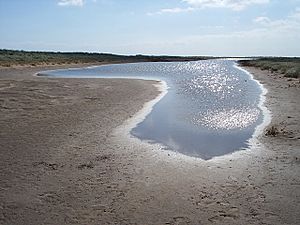Gibraltar Point facts for kids
Quick facts for kids Gibraltar Point |
|
|---|---|
 |
|
| Lua error in Module:Location_map at line 420: attempt to index field 'wikibase' (a nil value). | |
| OS grid | TF560580 |
| Area | 437 hectares (1,080 acres) |
| Managed by | Lincolnshire Wildlife Trust |
| Designated: | 5 March 1993 |
| Reference #: | 589 |
Gibraltar Point is a special place on the coast of Lincolnshire, England. It's a national nature reserve, which means it's protected for its amazing wildlife and natural beauty. This area covers about 4.3 square kilometres (1.7 square miles).
The reserve is owned by Lincolnshire County Council and East Lindsey District Council. It is looked after by the Lincolnshire Wildlife Trust. They work hard to keep it a safe home for many plants and animals.
Gibraltar Point has different types of land. You'll find two lines of sand dunes, called the "east dunes" and "west dunes." Between them is a wide area of salt marsh. Closer to the sea, there are more salt marshes, sandy beaches, and shingle (small stones).
The reserve stretches for about 5 kilometres (3 miles) along the coast. It goes from the south end of Skegness to the top corner of The Wash. Gibraltar Point itself is at the very southern tip. This is where the North Sea coast changes direction towards Boston.
Over time, the coastline here has changed a lot. This is because of something called coastal deposition. This means sand and shingle are constantly being added to the land by the sea. For example, in the late 1700s, the west dunes were right by the shore. Today, they are about a kilometre (0.6 miles) inland!
In 2016, a new visitor centre opened at the reserve. It replaced the old one, which was damaged by a big storm called Cyclone Xaver. There are many paths to explore the area. You can also find artificial lakes and special hides (places to watch birds without disturbing them). The money from car parks helps to keep the reserve well-maintained.
Gibraltar Point is so important that it has several special titles:
- It's a SSSI (Site of Special Scientific Interest).
- It's a NNR (national nature reserve).
- It's a Ramsar wetland site, meaning it's a wetland of international importance.
- It's a SPA (Special Protection Area).
Amazing Wildlife at Gibraltar Point
This nature reserve is a fantastic place to see many different kinds of wildlife.
Birds of Gibraltar Point
Gibraltar Point is especially famous for its birds. Many types of wildfowl, waders, and gulls live here. The way the land is shaped makes it a perfect stop for migrating birds. These are birds that travel long distances between their breeding and winter homes. Many rare birds that are not often seen in the UK have been spotted here.
In recent years, some of the rare birds seen include the black stork, pallid harrier, and caspian tern in 2015. In 2014, visitors saw the broad-billed sandpiper and black-winged pratincole.
Some birds also choose Gibraltar Point as their breeding ground. These include the little tern, common shelduck, and ringed plover. The reserve is also very important for wader species that spend the winter here. Huge numbers of oystercatcher, grey plover, and red knot come to Gibraltar Point.
There is a special bird observatory at the site. It has been studying bird migration in the area since April 1949. Scientists here learn a lot about how birds move and live.
Plants of Gibraltar Point
The reserve is also home to interesting plants. One special plant found here is called sea heath. Gibraltar Point has the most northerly group of sea heath plants in all of Britain!

